Hurricane Recovery And Design
Battering of US GOM structures brings discussion of standards
The vast majority of infrastructure in the Gulf of Mexico survived intact, but some selective, significant loss occurred. Character and distribution of that damage may prompt industry experts to re-think offshore design standards.
Kurt S. Abraham, Managing/ International Editor
With the United States so dependent on the Gulf of Mexico (GOM) for oil and gas, the one-two punch delivered by Hurricanes Katrina and Rita during August and September has created unprecedented challenges. Last month, Secretary of the Interior Gale Norton issued a preliminary report on damage to upstream facilities.
Norton said that a significant portion of GOM oil and gas output affected by Katrina and Rita might take several months to resume, while major repairs to a select minority of facilities would extend well into next year. Only a very small percentage of production in the storm-impacted area is expected to be lost permanently. Moreover, said Norton, “Despite such intense winds and powerful waves offshore, we experienced no loss of life or significant spills from any offshore well on the Outer Continental Shelf (OCS).”
Of 4,000 platforms that MMS administers, 3,050 were in the paths of Katrina and Rita. An early assessment found that 109 older, “end-of-life facilities” were destroyed, representing 1.7% of GOM oil production and 0.9% of natural gas output. Another 53 platforms suffered significant damage.
“None of the old structures were designed to today’s design criteria, including most structures in the mud slide areas in the GOM,” said Tim Sampson, API’s coordinator for drilling and production operations. “MMS has data on the ages of old structures that were lost. This was the majority with a few newer exceptions. Overall, it paints a pretty good picture, even though Rita, particularly the dirty side, ripped right through the heart of the producing area.”
In terms of rig damage, “ this was an unprecedented event, a Cat. 5 storm ripping through the center of offshore activity in the Gulf,” said Brian Petty, IADC’s senior vice president for Government Affairs. “As far as the total number of rigs either destroyed or damaged, the numbers are not yet clear. A few close-in (to the shore) jackups sank and went to the bottom of the Gulf. They are likely to be written off. A few others may be able to be repaired. Our members carry insurance for these contingencies. But it’s just too early to know what the final damage tally will be.”
Before Katrina came through producing areas on Aug. 28 – 29, total, normal Gulf output was 1.5 million bopd and 10 Bcfgd. By Sept. 19, the amount of production shut in had been whittled down to 837,648 bopd and 3.37 Bcfgd. But then came Rita, after which the peak of shut-in production on Sunday, Sept. 25, hit 100% of oil output and 80.47% of gas output (8.05 Bcfd). As of Oct. 21, the amount of shut-in production had only reduced to 986,805 bopd (65.79% of normal output) and 5.34 Bcfgd (53.37% of normal output). Much of the shut-in capacity was waiting on repair or re-start of downstream pipelining and refining capacity. What follows are significant samples of the character and quantity of damage sustained from both hurricanes.
HURRICANE KATRINA DAMAGE
When it landed at Burris, Louisiana, east of New Orleans, Hurricane Katrina had sustained winds of 135 mph. However, the storm’s winds had been even higher, earlier, when it sliced through producing areas of the east-central Gulf of Mexico, Fig. 1.
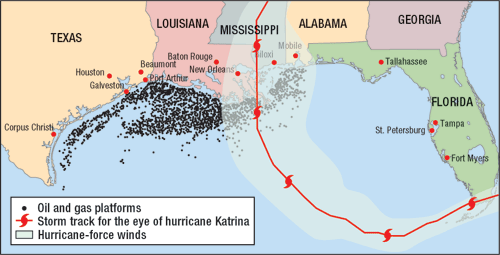 |
Fig. 1. Hurricane Katrina slammed into the East-Central section of GOM production facilities during Aug. 28 – 29, 2005.
|
|
As calculated by Earth Science Associates (ESA), about 556,000 bopd were produced during 2004 from fields within 60 mi of the path of Katrina’s eye. This equals 38% of total GOM output. Of that volume, 379,000 bopd were within 30 mi of the storm’s center. Also, 2 Bcfgd were within 60 mi of the storm track, of which about half were within 30 mi. Production in the most severely affected areas was concentrated among just a few companies. The largest operator within 30 and 60 mi from the storm track was Shell. According to MMS figures, Katrina destroyed 46 platforms and four rigs.
Platform problems. In terms of total structures lost, Apache Corp. appears to have sustained the greatest loss during Katrina. The company said that it lost eight production platforms, from which 7,158 bopd and 12.1 MMcfgd were produced. The lost platforms include Main Pass 312-JA; South Timbalier 161-A; South Pass (SP) 62-A; SP 62-B; West Delta (WD) 103-A; WD 103-B; WD 104-C; and WD 133-B.
The most significant damage from Katrina went to Shell, which had major problems at its Mars TLP (Mississippi Canyon Block 807), Fig. 2, Ursa TLP, Cognac fixed platform and West Delta 143 gathering hub platform. Subsequent assessments found no underwater damage at any of these facilities, but topsides damage is considerable. Shell said that Mars is not likely to go back on-line before sometime in 2006. Outlook for the other structures is not much better. Prior to shutting in, Mars produced 150,000 bopd and 170 MMcfgd.
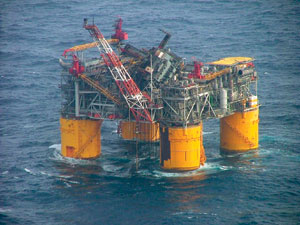 |
Fig. 2. Shell’s Mars TLP sustained major topsides damage.
|
|
Marathon Oil’s three South Pass platforms had major damage, including structural problems on two of the facilities. Assessment teams estimated that the platforms will require several weeks to several months to repair. They represent 1,500 bopd and 7.5 MMcfgd.
In the Main Pass area, Noble Energy’s 306 D platform (410 boed, net to the company) was lost. No further information was available as to whether it would be replaced. El Paso Corp. also lost one platform. Its West Delta 137 facility was destroyed, but that unmanned platform accounted for only 1.0 MMcfe per day, net to El Paso.
Newfield Exploration reported that its Main Pass 138 A platform was lost in Katrina. Prior to the storm, this facility had produced 1,500 bopd. McMoRan Exploration experienced minor damage to platforms at Main Pass Block 299 (Green Canyon Blocks 338 and 339; 3,500 bopd) and Main Pass Block 86 (Mississippi Canyon Blocks 538 and 582; 16 MMcfe per day). Output from both facilities was due to be fully restored before the end of 2005. Murphy Oil also reported minor damage at its Front Runner and Medusa deepwater facilities. As this article went to press, output had been restored at Front Runner, but Medusa was still off-line, due to downstream pipeline issues.
Rig damage. Katrina damaged four GlobalSantaFe (GSF) semisubmersibles, including the GSF Arctic I, GSF Development Driller II, GSF Celtic Sea and GSF Development Driller I. Most of the damage was confined to mooring systems. The first three semis were due to begin normal GOM operations during fourth-quarter 2005. However, the GSF Development Driller I sustained water damage to some of its thruster control systems. It was not projected to resume work until first-half 2006.
Two Hercules Offshore jackups were affected. The Hercules 25’s derrick fell on the quarters in Breton Sound Block 46. That rig has been judged to be “beyond saving.” Over on Mobile Block 819, the Hercules 30 was listing significantly after Katrina. It has since gone to a shipyard for repairs.
With the exception of one jackup, all of Rowan Companies’ rigs sustained minimal damage during Katrina. However, the Rowan New Orleans capsized and sank in 155 ft of water in Main Pass Block 185 offshore Louisiana. It had a $7.4-million carrying value and was insured for $8.5 million.
Diamond Offshore’s Ocean Warwick jackup had been on Main Pass Block 299, about 12 mi offshore Louisiana. It was eventually found by a fixed-wing aircraft, washed up on Dauphin Island off the coast of Alabama, Fig. 3. That site is 66 mi northeast of the original location. The jackup sustained major damage and has been declared a “total constructive loss.” It was insured for about $50 million.
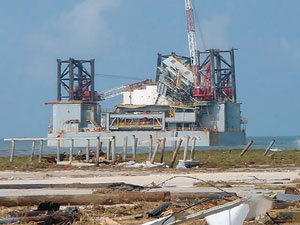 |
Fig. 3. Diamond Offshore’s Ocean Warwick jackup washed up onto Dauphin Island, Alabama, far from its original location.
|
|
In addition, Diamond Offshore’s Ocean Quest semisubmersible received minor damage from Katrina while on Mississippi Canyon Block 161 (Noble Energy). Two weeks of repairs were completed in mid-October. Also, the Ocean Voyager semisubmersible broke free from its moorings and was found 9 mi north of its pre-Katrina location on Mississippi Canyon Block 711. Repairs to the mooring system and other components were set to take up to eight weeks, completing in late October.
Transocean’s Deepwater Nautilus semisubmersible sustained damage to its mooring system and lost roughly 3,200 ft of marine riser and a portion of its subsea well control system. The rig sustained additional damage, primarily to thrusters mounted beneath its hull, when it was grounded following the failure of a tow line utilized by a vessel that was towing the rig away from Rita’s projected path. The Deepwater Nautilus was expected to mobilize to a GOM location, to attempt to retrieve the lost portion of its control system. The company expected the rig to be out-of-service for 30 days during fourth-quarter 2005, with about 60 days of additional out-of-service time required during first-half 2006 to complete all repairs.
Nabors Industries lost its Super Sundowner XII platform rig (West Delta Block 117, Anglo-Suisse Offshore). The rig was lost, when the operator’s platform collapsed. In addition, Nabors’ Dolphin 110 workover jackup sustained minor damage, due primarily to water intrusion through blown-out windows in the pilothouse and quarters. The unit had been working on West Delta Block 29 (W&T Offshore). It was moved to a dock for repairs on the quarters, a full mast inspection and potential repairs to one leg.
Noble Drilling had one semisubmersible, the Noble Jim Thompson, break loose from its mooring lines and drift 17 mi north-northeast of its location. The rig had been on Mississippi Canyon Block 935 (Shell). It did not sustain any material damage. In West Delta Blocks 73 and 74 (ExxonMobil), Pride International’s Pride 210 and Pride 211 platform rigs sustained damage to their masts. Because each rig’s net value was less than $1 million, the company was determining whether to repair or scrap the units.
ENSCO reported significant damage to its ENSCO 29 platform rig (Mississippi Canyon Block 21, Taylor Energy). It was not known whether the rig would be repaired or written off. In addition, the ENSCO 7500 semisubmersible’s towline parted. The vessel was due to spend 30 days in a shipyard for repairs, ending in late November.
A Helmerich & Payne platform rig experienced significant damage. Rig 201, which operated on Shell’s Mars TLP, lost its entire derrick and suffered considerable damage to the rig floor and substructure. At press time, the firm did not have a damage estimate, but it was anticipated that insurance proceeds would cover the loss.
TODCO said that its Rig 15 inland barge experienced flood damage on Lake Worthington, Louisiana. In addition, some minor damage occurred to the THE 200 and THE 204 jackups.
HURRICANE RITA DAMAGE
On Sept. 23 and 24, 2005, Hurricane Rita ripped through the Gulf production areas with maximum wind speeds up to 140 mph. According to ESA, about 250,000 bopd were produced from fields within 60 mi of the path of Rita’s eye, or 17% of average 2004 GOM production. Of that volume, 130,000 bopd were produced within 30 mi of the storm’s center. Also, 2.84 Bcfgd were produced from fields within 60 mi of Rita’s path, of which two-thirds were produced within 30 mi.
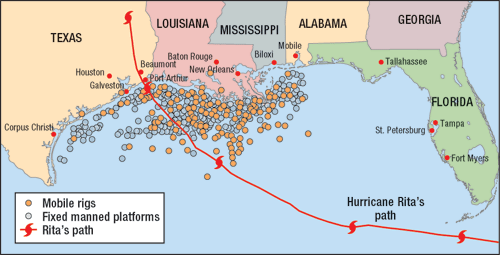 |
Fig. 4. Hurricane Rita affected a greater number of facilities, when it slashed through the West-Central Gulf during Sept. 23 – 24, 2005.
|
|
ESA said that in the most severe areas, wells operated by Shell and Chevron were likely to be among the most affected. Compared to Katrina, Rita had a proportionately greater impact on gas output. Rita also had a much broader impact across operators. In Katrina, 85% of capacity within 60 mi was operated by the top 10 exposed companies. In Rita, the top 10 accounted for 54% of capacity at risk. An early MMS tally found that Rita destroyed 63 platforms and one rig.
Platform problems. As ESA predicted, Chevron’s facilities sustained significant damage. Combined effects of Katrina and Rita damaged a number of production platforms, and 14 structures were toppled. Most of the damage was due to Rita. Among the casualties, the Typhoon TLP capsized and remained upside-down, Fig. 5. Chevron formed an investigative team to determine why the facility was lost. A restoration team will recommend how best to restore field production.
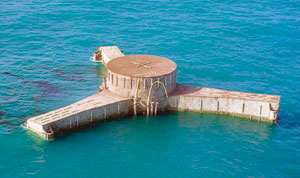 |
Fig. 5. Chevron is investigating why its Typhoon TLP capsized, remaining upside-down at its deepwater site.
|
|
Independent Stone Energy lost the South Marsh Island 108 D and Vermillion Block 225 A and B platforms. Net volumes to Stone from these facilities had been 18 MMcfe per day. In addition, Stone identified five lesser structures or caissons that were lost. These structures represented another 6 MMcfe per day. Stone is evaluating options for recovering the lost output.
Another independent, Newfield Exploration, lost three platforms, including South Marsh Island 49 B, East Cameron 151 C and East Cameron 286 B. Combined net output from the three facilities was 5.6 MMcfe per day. Denver-based Forest Oil lost the Eugene Island 314 platform. Fortunately, the structure was non-producing and scheduled for abandonment.
Pioneer Natural Resources lost the East Cameron 322 platform, which had produced 600 boed. The firm said that the financial impact is under evaluation, but it will not be known until a subsea damage assessment and an estimate of abandonment costs are completed. Apache Corp. said that it lost one structure at Ship Shoal 193 B.
Nexen sustained significant topsides damage at its Vermillion 321 and 340 platforms, as verified by inspections. Their combined output prior to Rita was 3,900 boed. Meanwhile, three ConocoPhillips platforms producing small Green Canyon fields sustained damage. However, their production impact for the remainder of 2005 was termed “minimal.” Of 17 structures operated by Seneca Resources, only the Vermilion 225A platform suffered moderate damage. Its pre-Rita output had been about 4 MMcfgd.
Rig damage. Compared to Katrina, Rowan did not fare nearly as well during Rita. The company’s Rowan Louisiana jackup was severely damaged. In addition, three jackups were missing and apparently had sunk, including the Rowan Odessa, Rowan Halifax and Rowan Fort Worth. The Rowan Louisiana’s hull, with some leg section intact, survived and was aground near Cameron, Louisiana. Underwater surveys conducted early last month had shown the detached legs of each of the other three jackups at their pre-storm locations, but very little other debris was found. Those jackups were collectively insured for $26 million more than their aggregate carrying value.
Rowan Chairman and CEO Danny McNease said he was taking steps to replace lost rigs and their revenues, including utilization of resources in Rowan’s manufacturing division. “We are reviewing the economic feasibility of accelerating the construction of our third Tarzan Class jackup, the Hank Boswell, which is currently on schedule for delivery during the fourth quarter of next year,” said McNease. “We are also reviewing the possibility of accelerating the construction of Tarzan IV.”
Two GlobalSantaFe (GSF) jackups went missing for several days. The GSF Adriatic VII and GSF High Island III were finally found on Sept. 28, in shallow waters offshore Louisiana, about 80 mi from their drilling sites. GSF said the rigs sustained severe damage. Whether they were damaged beyond repair was not yet determined as this article went to press. The two rigs’ combined net book value is $22.2 million, and they are insured for $125 million.
Noble Drilling said major damage was incurred by its Noble Max Smith semisubmersible and Noble Joe Alford submersible. Max Smith had been operating on Green Canyon Block 238 (BHP Billiton) before it drifted 123 mi after its mooring lines broke. The semi managed to miss running into Chevron’s Typhoon TLP, passing a comfortable 2.5 mi south and west of the TLP. Damage (Fig. 6) to Max Smith includes a hole of about 8 by 20 ft in the starboard outboard column at the 96-ft level, a crossover deck on the starboard side and the main deck outboard of an anchor winch. The rig is in a shipyard at Pascagoula, Mississippi, to undergo repairs until first-quarter 2006.
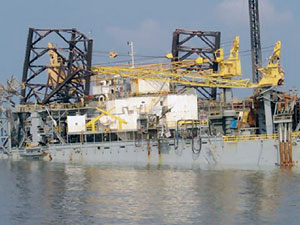 |
Fig. 6. The Noble Max Smith jackup went on a wild, 123-mi ride before coming to a rest.
|
|
Noble’s Joe Alford moved about 8 mi off its location in Vermillion Block 52 (Arena/ ADTI). The submersible’s damage comprised bent or broken support members below the hull. It was scheduled to be repaired in a shipyard at Sabine Pass, Texas, with a return to service in December. Meanwhile, the Noble Lorris Bouzigard semisubmersible broke at least one of its 10 mooring lines, but the remaining lines held the unit in position less than a mile from its original location (Garden Banks Block 244, Petrobras). Three more semis, Noble Amos Runner, Noble Paul Romano and Noble Therald Martin, were undamaged but drifted 75 mi, 118 mi and 89 mi, respectively, from their locations in Green Canyon Blocks 765 (Kerr-McGee), 518 (Anadarko Petroleum) and 236 (Chevron).
In Green Canyon Block 822 (BP), the Transocean Marianas semisubmersible was forced off its drilling location during Rita, causing damage to the mooring system. Further investigation also revealed damage to the unit’s thrusters mounted beneath its hull and some hull damage, which caused partial flooding of one column. The Transocean Marianas was scheduled to enter a shipyard in Brownsville, Texas, where repairs were anticipated to take from three to four months, with a return to service during first-quarter 2006.
Diamond Offshore sustained minor damage to two semisubmersibles, when both rigs broke free of moorings. The Ocean Saratoga eventually grounded in about 35 ft of water on Vermillion Block 111, offshore Louisiana, or roughly 100 mi northwest of its original location (Green Canyon Block 157). The rig’s repairs were slated to finish by late October. Meanwhile, the Ocean Star was also grounded in 35 ft of water on Eugene Island Block 142, about 100 mi north of its original location (Green Canyon Block 768). It underwent repairs that were scheduled to complete in mid-November.
Three Nabors Industries’ rigs suffered minor damage. Barge Rig 300, operating on inland waters east of Cameron, Louisiana, was submerged but remained on station. It sustained water damage to electrical, power, mud pump and other systems. The rig was moved to a shipyard for several weeks of repairs. Two of Nabors’ five jackups in Sabine Pass were damaged. Dolphin 111 had windows blown out in the pilot house and quarters, resulting in water damage to control systems and the quarters. Rig 54’s mast was blown over, but a substitute mast was available, allowing Nabors to return the rig to service in a few weeks.
Some minor issues developed for three ENSCO jackups. On ENSCO 68, the drill floor shifted while the vessel was stationed on Vermillion Block 164 (ExxonMobil). Its sister, ENSCO 69, saw its skid-off drilling package shift on the oil company platform. This vessel is not slated to be in a shipyard until February 2006. Finally, the ENSCO 90 was said to not be “in trim” (listing) at South Marsh Block 130.
After Rita, one of Hercules Offshore’s jackups, Hercules 21, was listing precariously at Main Pass Block 21. No other information was available.
RECOVERY/ DESIGN CONSIDERATIONS
As damage tallies become more defined, the question now becomes one of not only how to recover from 2005’s hurricanes, but also one of how the US upstream industry should reconsider its design criteria and operating practices.
One of the industry’s most respected experts, who has definite ideas about the state of offshore design and its resistance to hurricanes, is AMEC Paragon Senior Executive Vice President Ken Arnold. A 40-year veteran of facilities engineering design and project management, Arnold’s early career years were spent with Shell in the mid-to-late 1960s, where he gained plenty of experience dealing with a period of strong hurricanes. He later founded Paragon Engineering Services, which was acquired by AMEC earlier this year.
“I’m one of the few guys left in the industry who can remember several hurricanes in a row over several years in a row – that was in the late 1960s,” recalls Arnold. “There was at least one good one every year, but we learned from them and developed better design standards. Many existing structures in the Gulf were built to those standards, which have served us well. That having been said, this year’s hurricane damage indicates that we may need to re-think some of our assumptions (Fig. 7).”
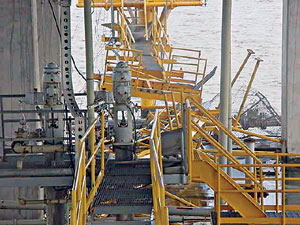 |
Fig. 7. This damage is fairly typical of older, smaller GOM production facilities.
|
|
Indeed, said API’s Sampson, “People have to remember that it’s been about 90 years since we’ve had two hurricanes come into the Gulf at this magnitude, back-to-back.” Arnold said that to gain a complete picture, one must consider four kinds of damage: wind; submarine slope instability, or landslides (responsible for pipeline damage and platform losses); waves; and mooring systems.
Ironically, these topics and others were discussed at the 2005 Offshore Hurricane Readiness and Recovery Conference, held in Houston during July 26 – 27, 2005. Unfortunately, the attendees had almost no time to think about beginning implementation of the conference’s recommendations before Katrina materialized. Adding further irony to the situation, at least seven technical papers (17733, 17735, 17736, 17737, 17738 and 17740) at last May’s OTC addressed specific situations and shortcomings related to last year’s Hurricane Ivan. In fact, Shell and Chevron, who were impacted heavily by Katrina and Rita, respectively, presented four of the seven OTC papers. Another seven OTC papers were indirectly related to problems with hurricanes.
Wind damage. This term refers to rigs getting blown off of platforms or the damage to topsides facilities, as occurred on Shell’s Mars platform after Katrina. “When I look at all of it, I think our current standards are good,” said Arnold. However, I think that some people have gotten sloppy in their operations. The tie-downs, for instance, weren’t good enough.” Indeed, in the opening presentation to the July Houston conference, Chevron’s Sandi Fury noted that the group should “consider enhancements to API RP 4F, to address loading issues and tie-downs associated with drilling structures.”
“What we intend to do is eventually evaluate what happened to individual structures in the Gulf,” said Sampson. “What we expect to find is that the structural members are pretty well designed. Now, we may have to look at the topsides. For the most part, fixed structures and floaters held up well. The big item being questioned by everybody is mooring on drilling rigs.”
In a presentation to the July Houston conference, Tommy Laurendine of the MMS delivered the results of a survey of 3,922 GOM structures, by age. He found that 1,062 of them, or just over a fourth, were less than 10 years old, and another 844 were 11 to 20 years old. There were 939 structures aged 21 to 30 years, with 607 dating back 31 to 40 years. Amazingly, there were 470 structures still installed that were more than 40 years old.
Submarine slope instability, or landslides. Although this phenomenon was certainly present during Katrina and Rita, it was particularly onerous during Hurricane Ivan last year. Two types of damage are spawned by this feature – pipeline damage and platform losses.
“Back in the 1960s, when a bunch of storms went through the Gulf near the mouth of the Mississippi River, several of us did a lot of work in the area of pipeline damage,” said Arnold. “In fact, my Master’s thesis was on that subject in 1967.” This is an area, he noted, where soils are very soft, and instability or landslides occur easily when a hurricane comes churning through. The amount of disruption is in proportion to the magnitude of the storm. “Since our original studying of this subject,” Arnold added, “There’s been some excellent work done by Jim Coleman with LSU and Ralph Hooper with Fugro. They really did some seminal work to predict what would happen to pipelines. What has happened is in line with what they would have expected.”
Hooper made a presentation to the July Houston conference, in which he tried to explain why the Mississippi Delta front is prone to seafloor failures so destructive to platforms and pipelines. He noted that the constant seaward advance of the delta, via the Mississippi River, incorporated mudflows. Furthermore, “deposition rates are 1 to 2 ft/year in front of the major passes,” said Hooper. “Sediments deposited by the Mississippi are primarily low-permeability clay with silt. This results in weak-strength profiles more than 300 ft thick and numerous landslides that create a unique seafloor.” In other words, soft and unstable.
For pipelines, Arnold argues that there is nothing that one can do to keep them from sustaining damage at some point in their lives, other than trying to avoid the worst areas through proper route selection. “You just have to know that sometimes you’re going to lose that pipeline,” he said. “But the lines normally can be repaired within a reasonable time, and since they’re shut in, they’re not a pollution hazard.” He said that it is a business risk that must be taken, similar to the fact that a certain percentage of snow skiers are going to break their legs going downhill.
As regards platform losses, some were a result of mudslides, because the hurricanes came near the Mississippi Delta. These were older platforms that were not designed with the currently known technology for mudslides. This includes anything installed before the early 1980s. “However, said Arnold, “The wave types that we ran into in these storms were a little different than we had expected. Wave periods altered the mud slides that we expected.”
Waves. Operators have lost platforms in these storms, because wave heights were greater than engineers would have expected, and that is the puzzlement. They can rationalize and say that these were 1-in-1,000-year waves, and that they only designed for 1-in-100-year waves. Therefore, one can say that these are 1-in-1,000-year waves, or should it be said that there is something wrong with the understanding of 1-in-100-year waves? “I have no data to back it up either way,” said Arnold. “The problem has to do with understanding ‘wave crest elevation.’ In other words, the wave’s lateral force is concentrated at its crest. If you guess wrong at what that elevation should be, then you would put the lower deck on a platform too low, and the wave will do significant damage to the platform.”
Arnold said that he suspects that some of these high-elevation waves are “rogue waves” within a storm. “We need to go back and look at our statistics. Our understanding of wave crests is really based on 1970s and earlier data. We have a far greater build-up of data in recent years at our disposal, as opposed to 30 years ago.”
The real problem may be in deep water. When engineers do a design, they figure out what wave crest they want to provide for and then add an “air gap” for room over the top of the wave. “There’s clearly something wrong with our perception of how large waves can be in the deepwater areas and how we are designing for them,” explained Arnold. “Another reason that we’ve lost structures is maintenance, especially from a cathodic protection standpoint. Some of these platforms that were lost may have had cracks in their joints, making them more susceptible to fatigue failures. I suspect that we had some of this going on during these hurricanes, particularly with Rita.”
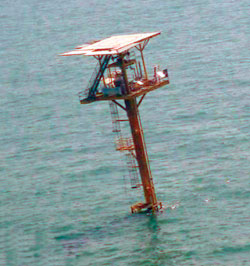 |
Fig. 8. Single-well caissons are ideal for developing small, marginal reserves in shallow-water areas, but their ability to withstand the strongest hurricanes is called into question.
|
|
Over time, engineers have gotten much better at knowing stresses, once they know the loading conditions. In the past, when they did not know how to calculate something, they would add “robustness,” just to err on the side of caution. “I suspect that the platforms that the industry designs today have less reserve strength,” surmised Arnold. “We have calculated designs more tightly, because we can, and because it’s cheaper, too. We’ve also moved away from four-pile platforms to tripods. We did this to be more efficient, and to produce economics that allow us to develop marginal reserves. But the down side of this practice is that you end up with structural configurations that have less reserve capacities (Fig. 8).”
Mooring systems for semis. These mooring systems are designed to withstand winter storms and low-grade hurricanes. According to Arnold, the rationale is to have a mooring system that can be installed and disconnected reasonably. Historically, it’s been a trade-off that’s proven to be efficient. Once again, the industry is trying to be efficient in drilling exploration wells. However, the problem now is that there are more structures out there, and the chances of a semi bumping into something is far greater.
During the drilling breakout session of the July Houston conference, one presenter noted that five mobile rigs incurred damage to moorings during Hurricane Ivan. In all cases, the 100-year storm event standards were exceeded. Furthermore, during a session on a joint industry project to address proposed changes in rig mooring, it was stated that during 13 years of operations, only three storms have caused mooring failures. These include Andrew (1992, two rigs), Lili (2002, one rig) and Ivan (2004, five rigs). Based on early data, it appears that Katrina and Rita have inflated those totals considerably.
Also at last July’s conference, Evan Zimmerman of Delmar Systems, Inc., outlined the factors that should be considered in designing a mooring system for any particular rig. These included whether or not to utilize a conventional system, whether to accommodate anchor change, and decisions on pre-set moorings, buoyed lines, synthetic inserts and probable break points.
At the same time, “there’s hardly anything that you can do to completely secure a mobile offshore drilling unit in the teeth of a Cat. 5 storm,” noted IADC’s Petty. “This is especially true, given that it’s not fixed to the seafloor. It remains to be seen whether any design changes can be made that will make a discernable difference.”
Furthermore, said Arnold, “This is not the first time that rigs have broken loose and bumped into something. During Hurricane Betsy in 1965, the first semisubmersible ever operated ran into a West Delta platform. It destroyed the platform and then sank. The semi was designed by Shell, and, ironically, it was a Shell platform that it ran into.”
Future remedial conferences. Everyone consulted for this article agrees that the offshore E&P industry will be studying the results of Katrina and Rita, looking for trends and specific problems to be addressed at special conferences in the near-future. Already, there is going to be a meeting on Nov. 17.
“At that meeting,” said Petty, “MMS will have a discussion with IADC and the Offshore Operators’ Committee (delegation to be led by Chevron’s Sandi Fury and featuring Alan Verrett of Murphy Oil). We’ll be accompanied by several of our members’ representatives to comment at the meeting. This pairing of back-to-back hurricanes was a significant event that we take very seriously. I’m sure that our members will want to do all they can to study the situation and, if necessary, update design standards and practices where needed.
Indeed, MMS Gulf of Mexico Region Director Chris Oynes told the July Houston conference that his agency had already awarded six contracts totaling more than $600,000 for studies. These studies were to examine the impact of Hurricane Ivan on the Gulf infrastructure. Results would be used in assessing the adequacy of current design standards and practices.
“We’ve probably got a lot of homework to do between now and next hurricane season,” said API’s Sampson. “Of course, as an industry, we’re talking to Congress about not putting all our eggs into the one basket of the Central and Western Gulf of Mexico. The good news is that our entire industry always comes back strong.” 
ACKNOWLEDGMENTS
The author would like to thank Ken Arnold of Amec Paragon Engineering Services, Tim Sampson of API and Brian Petty of IADC for their help in sorting out recent events and defining the near-term tasks that await the industry’s attention.
|










